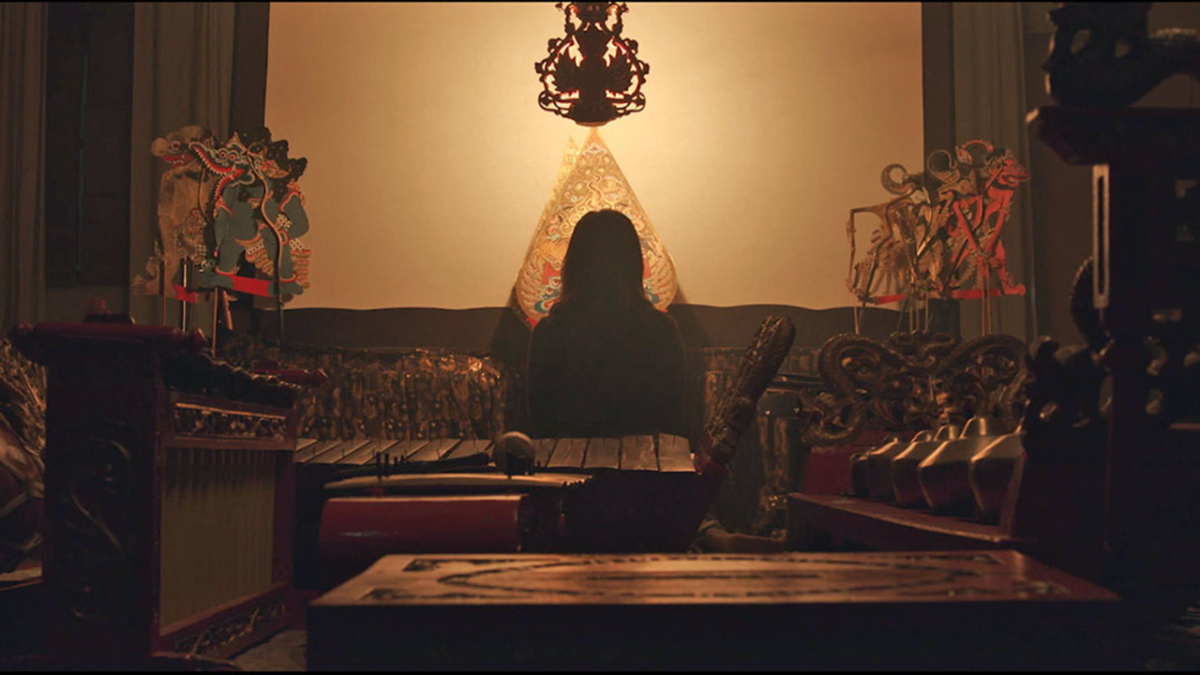Andrea Nirmala Widjajanto talks about her hypnotic short
Written by: Patricia Kusumaningtyas
In the short film “Srikandi,” directed by Indonesian director Andrea Nirmala Widjajanto, reality is not what it seems. The viewers are immersed into a world of Javanese mysticism through the lens of Anjani, a daughter of a dalang (a wayang shadow puppeteer), whose life is at a crossroads when her father dies and her mom is selling all of the family’s wayang equipment.
The worldbuilding of “Srikandi” is manifested through things small and big: from Anjani’s mother’s orders to wash her feet before entering the house so no demons will follow her, to the spellbinding centerpiece of the film, where Anjani becomes possessed by the spirit of her father as she tries putting on a wayang performance. Widjajanto’s eye intensifies this worldbuilding through her use of soft lighting, the lush color palette of an Indonesian home, and her cultural sensitivity through her Javanese background. Additionally, the calming yet hypnotic gamelan – Indonesian percussion ensemble – score increases the tension and catapults the film into a higher plane of existence.
“Srikandi” started out as an entry to a local Vancouver film competition; now it’s on the film festival rotation, with a screening at 2021’s Toronto International Film Festival and back in Indonesia at 2021’s Jogja-Netpac Asian Film Festival. I sat down with Widjajanto to talk about “Srikandi,” her trajectory as a filmmaker, and being an Indonesian woman filmmaker in the white male-dominated film industry.
Patricia Kusumaningtyas: Where did you get the idea for this film? When you grew up, were you familiar with wayang shadow puppets and the myth of Srikandi?
Andrea Nirmala Widjajanto: I had this idea my first year abroad when I was still in film school. It’s mostly triggered by homesickness, and I wanted to do something that was Indonesian. And to be honest, my first year of film school, I didn’t know what my voice was. My first instinct was to go to wayang. Sometimes my grandpa would take me to wayang shows in Klaten, Indonesia, but I would never stay the whole time because they would run from 10pm to 6 in the morning, and I could never stay awake for them and I barely understood Javanese. For “Srikandi,” I was trying to do something that was tied to my roots, and that was the one art form that caught my eye.
The choice to do the myth of Srikandi came very late. I found Srikandi through talking to a dalang from the Indonesian consulate in Vancouver. The first chapter that I found was about her younger days, where she wanted to train but her father said no just because she’s a woman. She escaped from home, and I thought that that was exactly what I needed for my ending. I think that part comes from a very personal place because the film industry is very white male-dominated, and that’s where the personal kind of fits in: It’s me trying to find my place in this industry.
PK: Speaking of the white male dominated North American film industry, as you’re getting immersed in it, what was your biggest culture shock as an Indonesian woman filmmaker?
ANW: I think it’s the results of that “success.” After my film got into TIFF, I recognized what it did for other people in my shorts program cohort. People immediately got signed into TV directing deals, or got an agent signed, got production companies hiring them to make ads and music videos, and for me it was crickets. In the beginning, I thought, maybe that’s because where I’m based, because most of these people were based in New York, Los Angeles, or Toronto, and I was still based in Vancouver where it was mostly a service industry city. But then I talked to more people, and I was working with this DP and she was just like, “It’s because you’re an Asian woman, and you made this film in a foreign language.” It would’ve been easier to get signed if I’d made an English-language film.

PK: One of my favorite sequences in the film is where our main character plays with the shadow puppets, and she starts dancing erratically over the screen, becoming a wayang-like figure herself. Can you tell me more about how you made that scene work?
ANW: I think that was the first idea I had for the film… In the scene, the spirit of her dad possesses her. It was the idea of, even though you see her becoming a dalang, she was still puppeteered by a man. It’s still in male control, because it’s not a woman teaching her. At the end of the day, she hasn’t found her own voice; it’s still his teachings that are transferred to her. And I think that’s where the mirror for the myths kind of work, because these myths are still very sexist and patriarchal: a woman viewed as an object, as a shadow. For the music in that scene, I can’t take credit for that. That is fully the dalang’s work. He recorded several different instruments on that day, and our composer blended it all together.
PK: Looking back to your first year in film school, do you think you’ve found your vision as a director now?
ANW: That’s the thing about my work; it’s so personal that it’s so hard to detach from it. I know what I want to do now; I want to work within the space of Indonesian myths and folklore. I want to work in the genre of sci-fi and horror much more than drama, because that space allows me to be more metaphorical with visual motifs and social commentary. In terms of what my goal actually is, I’m going into more political stuff, and that’s personal to me. I talked to my partner about how this would be my last personal short, then after that, someone breaks my heart again. (Laughs.) I’m still experimenting but I’m starting to write a feature, that’s my goal for next year.
PK: Your story reminded me of a quote by filmmaker John Cassavetes: “Films are a road map through emotional and intellectual terrains that provide a solution to how one can save pain.” Do you feel like your films are a way for you to process your emotions?
ANW: Yeah. Because I can’t afford a therapist, let me just make a film. And then I realize, oh wait, making a film is more expensive! (Laughs.)
My next film, “Bawang Merah Bawang Putih,” was funded by a mental health organization in Toronto; they wanted to fund films about people’s experiences during the pandemic regarding mental health, and for me, that was regarding my eating disorder, and that’s where the idea of the film came up. I decided to make a body horror piece, and I think it just makes more sense with the current state of mental health in Indonesia. The film allows me to be more honest with myself and accept that I was bulimic and sometimes still relapse. I think films work when my words aren’t enough.
This interview has been lightly edited for clarity.
Srikandi screened as part of AAIFF45’s “It’s a Mad, Mad Multiverse” shorts block.

